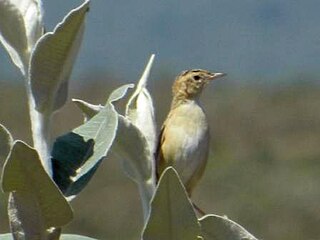
Martin Theodor von Heuglin, was a German explorer and ornithologist.

The yellow-fronted tinkerbird is a small bird in the family Lybiidae formerly known as yellow-fronted tinker barbet. It is sometimes considered conspecific with its southern counterpart, the red-fronted tinkerbird, Pogoniulus pusillus. Barbets are near passerine birds with bristles around the base of the bill and a world-wide tropical distribution.

The red-billed firefinch or Senegal firefinch is a small seed-eating bird in the family Estrildidae. This is a resident breeding bird in most of Sub-Saharan Africa with an estimated global extent of occurrence of 10,000,000 km2. It was introduced to Egypt, but the population there has become extinct. It was also introduced to southern Algeria where it is currently expanding northward.

The tinkerbirds or tinker barbets are the genus Pogoniulus of the Lybiidae, the African barbet family of near passerines, which was formerly included in the Capitonidae and sometimes in the Ramphastidae. Tinkerbirds are widely distributed in tropical Africa.

Lybiidae is a family of birds also known as the African barbets. There are 42 species ranging from the type genus Lybius of forest interior to the tinkerbirds (Pogoniulus) of forest and scrubland. They are found throughout sub-Saharan Africa, with the exception of the far south-west of South Africa.

The fawn-breasted waxbill is a common species of estrildid finch found in central Africa. It has an estimated global extent of occurrence of 1,800,000 km2. Estrilda paludicola, E. ochrogaster and E. poliopareia have been lumped into E. paludicola.

The Horus swift is a small bird in the swift family Apodidae that is found in sub-Saharan Africa. Horus, whose name this bird commemorates, was the ancient Egyptian god of the sun, son of Osiris and Isis.

The southern red-fronted tinkerbird, is a small bird in the African barbet family Lybiidae. It is found in southern Mozambique and eastern South Africa. This species was formerly regarded as conspecific with the northern red-fronted tinkerbird.

The black-backed cisticola or black-necked cisticola is a species of passerine bird in the family Cisticolidae. It is found in Burkina Faso, Chad, Republic of the Congo, Democratic Republic of the Congo, Ivory Coast, Eritrea, Ethiopia, Ghana, Guinea, Guinea-Bissau, Kenya, Mali, Nigeria, Senegal, Sierra Leone, South Sudan, Tanzania, Togo, and Uganda. Its natural habitats are subtropical or tropical dry lowland grassland and subtropical or tropical seasonally wet or flooded lowland grassland.

Yellow penduline tit is a species of bird in the family Remizidae. This small yellow passerine bird is found in semi-arid savanna regions of West Africa.

The black-backed cisticola or black-necked cisticola is a species of passerine bird in the family Cisticolidae. It is found in Burkina Faso, Chad, Republic of the Congo, Democratic Republic of the Congo, Ivory Coast, Eritrea, Ethiopia, Ghana, Guinea, Guinea-Bissau, Kenya, Mali, Nigeria, Senegal, Sierra Leone, South Sudan, Tanzania, Togo, and Uganda. Its natural habitats are subtropical or tropical dry lowland grassland and subtropical or tropical seasonally wet or flooded lowland grassland.

The Ethiopian white-eye, formerly known as Heuglin's white-eye or montane white-eye, is a small passerine bird in the white-eye family Zosteropidae. It is found in southeast Sudan, Eritrea and north, central and east Ethiopia. Its natural habitats range from subtropical or tropical moist montane forests, to subtropical or tropical high-altitude shrubland, plantations, and rural gardens.

The yellow-rumped tinkerbird is a bird species in the family Lybiidae, which is native to the moist tropical and subtropical regions of sub-Saharan Africa.
The moustached tinkerbird is a species of bird in the Lybiidae family . It is found in Kenya, Malawi, Tanzania, Uganda, and Zambia.

The green tinkerbird is a species of bird in the Lybiidae family . It is found in Kenya, Malawi, Mozambique, and Tanzania.

The Ethiopian large-eared roundleaf bat is a species of bat in the family Hipposideridae. It is found in Djibouti, Eritrea, Ethiopia, Kenya, Saudi Arabia, and Somalia. Its natural habitats are dry savanna, subtropical or tropical dry shrubland, caves, and hot deserts.

The African giant free-tailed bat, or African free-tailed bat is a species of bat in the family Molossidae. It is found in Democratic Republic of the Congo, Eritrea, Ethiopia, Kenya, Malawi, Mozambique, South Sudan, Tanzania, Zambia, Zimbabwe, and possibly South Africa. Its natural habitats are dry savanna and subtropical or tropical dry shrubland.

Heuglin's wheatear is a small passerine bird in the wheatear genus Oenanthe.

The African red-rumped swallow is small passerine bird in the swallow family Hirundinidae. It is found in northern areas of Africa south of the Sahara.

Eritrean gazelle is a species of gazelle found east of the Nile River in Eritrea, Ethiopia and Sudan. It was considered a subspecies of the red-fronted gazelle or conspecific with Thomson's gazelle and Mongalla gazelle by some authors in the past. This small gazelle stands nearly 67 cm (26 in) at the shoulder and weighs between 15 and 35 kg. The coat is dark reddish brown with a dark reddish stripe on the flanks, except for the underparts and the rump which are white. Horns, present in both sexes, measure 15 to 35 cm in length.

















